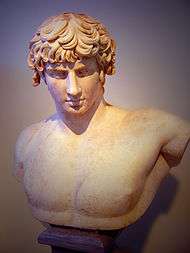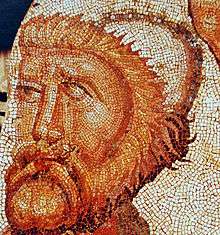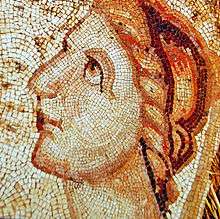Blond

Blond (male), blonde (female), or fair hair, is a hair color characterized by low levels of the dark pigment eumelanin. The resultant visible hue depends on various factors, but always has some sort of yellowish color. The color can be from the very pale blond (caused by a patchy, scarce distribution of pigment) to reddish "strawberry" blond or golden-brownish ("sandy") blond colors (the latter with more eumelanin). On the Fischer–Saller scale, blond color ranges from A (light blond) to O (dark blond).
Etymology, spelling, and grammar
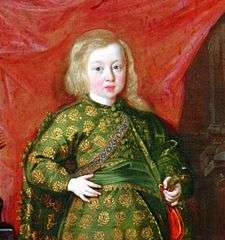
Origins and meanings
The word "blond" is first documented in English in 1481[1] and derives from Old French blund, blont meaning "a colour midway between golden and light chestnut".[2] It gradually eclipsed the native term "fair", of same meaning, from Old English fæġer, causing "fair" later to become a general term for "light complexioned". This earlier use of "fair" survives in the proper name Fairfax, from Old English fæġer-feahs meaning "blond hair".
The French (and thus also the derived English) word "blond" has two possible origins. Some linguists say it comes from Medieval Latin blundus, meaning "yellow", from Old Frankish blund which would relate it to Old English blonden-feax meaning "grey-haired", from blondan/blandan meaning "to mix" (Cf. blend). Also, Old English beblonden meant "dyed" as ancient Germanic warriors were noted for dyeing their hair. However, linguists who favor a Latin origin for the word say that Medieval Latin blundus was a vulgar pronunciation of Latin flavus, also meaning yellow. Most authorities, especially French, attest the Frankish origin. The word was reintroduced into English in the 17th century from French, and was for some time considered French; in French, "blonde" is a feminine adjective; it describes a woman with blonde hair.[3]
Usage
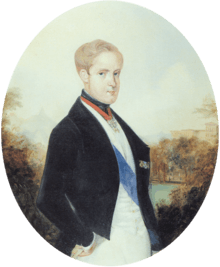
"Blond", with its continued gender-varied usage, is one of few adjectives in written English to retain separate masculine and feminine grammatical genders. Each of the two forms, however, is pronounced identically. American Heritage's Book of English Usage propounds that, insofar as "a blonde" can be used to describe a woman but not a man who is merely said to possess blond(e) hair, the term is an example of a "sexist stereotype [whereby] women are primarily defined by their physical characteristics."[4] The Oxford English Dictionary (OED) records that the phrase "big blond beast" was used in the 20th century to refer specifically to men "of the Nordic type" (that is to say, blond-haired).[5] The OED also records that blond as an adjective is especially used with reference to women, in which case it is likely to be spelt "blonde", citing three Victorian usages of the term. The masculine version is used in the plural, in "blonds of the European race",[5] in a citation from 1833 Penny cyclopedia, which distinguishes genuine blondness as a Caucasian feature distinct from albinism.[6]
By the early 1990s, "blonde moment" or being a "dumb blonde" had come into common parlance to mean "an instance of a person, esp. a woman... being foolish or scatter-brained."[7] Another hair color word of French origin, brunet(te) (from the same Germanic root that gave "brown"), also functions in the same way in orthodox English. The OED gives "brunet" as meaning "dark-complexioned" or a "dark-complexioned person", citing a comparative usage of brunet and blond to Thomas Henry Huxley in saying, "The present contrast of blonds and brunets existed among them".[8] "Brunette" can be used, however, like "blonde", to describe a mixed-gender populace. The OED quotes Grant Allen, "The nation which resulted... being sometimes blonde, sometimes brunette."[9]
"Blond" and "blonde" are also occasionally used to refer to objects that have a color reminiscent of fair hair. For example, the OED records its use in 19th century poetic diction to describe flowers, "a variety of clay ironstone of the coal measures", "the colour of raw silk",[5] a breed of ray, lager beer, and pale wood.[10]
Varieties
Various subcategories of blond hair have been defined to describe the different shades and sources of the hair color more accurately. Common examples include the following:


- ash-blond:[11] ashen or grayish blond.
- bleached blond, bottle blond, or peroxide blond[12] terms used to refer to artificially colored blond hair.
- blond/flaxen:[13][14] when distinguished from other varieties, "blond" by itself refers to a light but not whitish blond, with no traces of red, gold, or brown; this color is often described as "flaxen".
- dirty blond[15] or dishwater blond:[16] dark blond with flecks of golden blond and brown.
- golden blond: a darker to rich, golden-yellow blond (found mostly in Northeastern Europe, i.e., Russia, Estonia).
- honey blond or caramel blond: reddish blond.
- platinum blond[17] or towheaded:[18][19] whitish-blond; almost all platinum blonds are children, although it is found on people in Northern Europe. "Platinum blond" is often used to describe bleached hair, while "towheaded" generally refers to natural hair color.
- sandy blond:[20][21] grayish-hazel or cream-colored blond.
- strawberry blond,[22] Venetian blond.[23]
- yellow: yellow-blond ("yellow" can also be used to refer to hair which has been dyed yellow).
Evolution of blond hair

Natural lighter hair colors occur most often in Europe and less frequently in other areas.[24] In Northern European populations, the occurrence of blond hair is very frequent(what frequency?). The hair color gene MC1R has at least seven variants in Europe giving the continent a wide range of hair and eye shades. Based on recent genetic research carried out at three Japanese universities, the date of the genetic mutation that resulted in blond hair in Europe has been isolated to about 11,000 years ago during the last ice age.[25]
A typical explanation found in the scientific literature for the evolution of light hair is related to the requirement for vitamin D synthesis and northern Europe's seasonal less solar radiation.[26] Lighter skin is due to a low concentration in pigmentation, thus allowing more sunlight to trigger the production of vitamin D. In this way, high frequencies of light hair in northern latitudes are a result of the light skin adaptation to lower levels of solar radiation, which reduces the prevalence of rickets caused by vitamin D deficiency. The darker pigmentation at higher latitudes in certain ethnic groups such as the Inuit is explained by a greater proportion of seafood in their diet and by the climate which the Eskimos live in, because in the polar climate there is more ice or snow on the ground, and this reflects the solar radiation on to the skin, making this environment lack the conditions for the person have blond, brown or red hair, light skin and blue, gray or green eyes. This required condition in climates which have ice on the ground and places that are located in a region which has much or extreme amounts of solar radiation is commonly known as "escape the sun".
An alternative hypothesis was presented by Canadian anthropologist Peter Frost, who claims blond hair evolved very quickly in a specific area at the end of the last ice age by means of sexual selection.[27] According to Frost, the appearance of blond hair and blue eyes in some northern European women made them stand out from their rivals, and more sexually appealing to men, at a time of fierce competition for scarce males.[27][28]
Recent archaeological and genetic study published in 2014 found that, seven "Scandinavian hunter-gatherers" found in 7700-year-old Motala archaeological site in southern Sweden had both light skin gene variants, SLC24A5 and SLC45A2, they also had a third gene, HERC2/OCA2, which causes blue eyes and also contribute to lighter skin and blond hair.[29] Genetic research published in 2014 and 2015 also indicates that, Yamnaya Proto-Indo-Europeans who migrated to Europe in Bronze Age were overwhelmingly dark-eyed (brown), dark-haired and had a skin colour that was moderately light, though somewhat darker than that of the average modern European.[30] While light pigmentation traits had already existed in pre-Indo-European Europeans (both farmers and hunter-gatherers) and long-standing philological attempts to correlate them with the arrival of Indo-Europeans from the steppes were misguided.[31]
It is now hypothesized by researchers that blond hair evolved more than once. Published in May 2012 in Science, a study of people from the Solomon Islands in Melanesia found that an amino acid change in TYRP1 produced blonde hair.[32][33]
Relation to age
Blond hair is most common in light-skinned infants and children,[34] so much so that the term "baby blond" is often used for very light colored hair. Babies may be born with blond hair even among groups where adults rarely have blond hair although such natural hair usually falls out quickly. Blond hair tends to turn darker with age, and many children's blond hair turns light, medium, dark brown or black before or during their adult years.[34]
As blond hair tends to turn brunette with age, natural blond hair is rare and makes up approximately 2% of the world's population.[35]
Geographic distribution
Europe
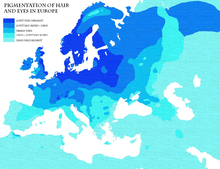
Blond hair is most common in Scandinavia and Baltic Sea countries, where true blondism is believed to have originated. The pigmentation of both hair and eyes is lightest around the Baltic Sea, and darkness increases regularly and almost concentrically around this region[37] with countries such as the UK, Ireland, Sweden, Norway, Denmark, the Netherlands, Germany, Finland, Estonia, Latvia, Lithuania, Poland, Belarus, Ukraine, Russia, etc. generally having larger proportions of blond people than countries further south in Europe.
In France, according to a source published 1939, blondism is more common in Normandy, and less common in the Pyrenees and the Mediterranean seacoast; 26% of French population has blond or light brown hair.[38] A 2007 study of French females showed that by then roughly 20% were blonde, although half of these blondes were fully fake. Roughly ten percent of French females are natural blondes, of which 60% bleach their hair to a lighter nuance of blonde.[39]
In Portugal, an average 11% of the population shows traces of blondism, peaking at 14.3–15.1% blondes in Povoa de Varzim in Northern Portugal.[40][41] In northern Spain, 17% of the population shows traces of blondism, but in southern Spain just 2% is blond.[42] In Italy, according to 20th century geneticist Biasutti, 12% of Italians exhibit various shades of blond,[43] but regional contrasts are pronounced with a greater occurrence in the northern and central regions (Veneto, Friuli, Valle d'Aosta and Bolzano) where the figure can reach 15–20% and a lesser occurrence in the south such as Sardinia where only 1.7% exhibited blondism and, with the exception of Benevento and surrounding area where blondism reaches 10–14.9%, compared to other southern regions where it averages around 2-7%.
Africa
Blondism is also a common sight among Berbers of North Africa, especially in the Rif and Kabyle region. Blondism frequency varies among Berbers from 1% among Jerban Berbers, 4% among Mozabite Berbers and Shawia Berbers, to 11% among Kabyle Berbers.[44] In South Africa where there is a significant population of Whites, mainly from Dutch and English ancestry, blondes may account for 3-4% of the South African population.
A number of blonde naturally mummified bodies of common people (i.e. not proper mummies) dating to Roman times have been found in the Fag el-Gamous cemetery in Egypt, "Of those whose hair was preserved 54% were blondes or redheads, and the percentage grows to 87% when light-brown hair color is added".[45] Excavations have been ongoing since the 1980s. Burials seem to be clustered by hair-colour.[46]
Oceania
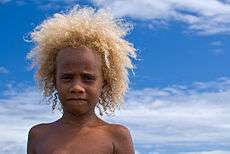
Aboriginal Australians, especially in the west-central parts of the continent, have a high frequency of natural blond-to-brown hair,[47] with as many as 90–100% of children having blond hair in some areas.[48] The trait among Indigenous Australians is primarily associated with children. In maturity the hair usually turns a darker brown color, but sometimes remains blond.[48] Blondness is also found in some other parts of the South Pacific, such as the Solomon Islands,[32][33] Vanuatu, and Fiji, again with higher incidences in children. Blond hair in Melanesians is caused by an amino acid change in the gene TYRP1.[32] This mutation is at a frequency of 26% in the Solomon Islands and is absent outside of Oceania.[32]
Asia
Blonde hair can be found in any region of Asia, including West Asia, East Asia, Central Asia, and South Asia. In these parts of Asia blond hair is generally seen among children that usually turns into a shade of dark brown in adulthood. Environmental factors, for example, sun exposure and nutrition status often contribute to changes in hair color in Asia.[49]
Genetic research published in 2014, 2015 and 2016 found that Yamnaya Proto-Indo-Europeans, who migrated to Europe in early Bronze Age were overwhelmingly dark-eyed (brown), dark-haired and had a skin colour that was moderately light, though somewhat darker than that of the average modern European.[30] While light pigmentation traits had already existed in pre-Indo-European Europeans (both farmers and hunter-gatherers) and long-standing philological attempts to correlate them with the arrival of Indo-Europeans from the steppes were misguided.[31]

According to genetic studies, Yamnaya Proto-Indo-European migration to Europe led to Corded Ware culture, where Yamnaya Proto-Indo-Europeans mixed with "Scandinavian hunter-gatherer" women who carried genetic alleles HERC2/OCA2, which causes combination of blue eyes and blond hair.[50][51][29] Proto-Indo-Iranians who split from Corded ware culture, formed Andronovo culture and are believed to have spread genetic alleles HERC2/OCA2 that causes blonde hair to parts of West Asia, Central Asia and South Asia.[51]
Genetic analysis in 2014 also found that people of the Afanasevo culture which flourished in Altai Mountains were genetically identical to Yamnaya Proto-Indo-Europeans and that they did not carry genetic alleles for blonde hair or light eyes.[52][50][51] Afanasevo culture was later replaced by second wave of Indo-European invaders from Andronovo culture, who were product of Corded Ware admixture that took place in Europe, and carried genetic alleles that causes blond hair and light eyes.[52][50][51]
In 2009 and 2014, genomic study of Tarim mummies discovered in the Tarim Basin in present-day Xinjiang, China, showed that they were also a product of a Corded Ware admixture and were genetically closer to the Andronovo culture (which split from Corded Ware culture)[51] than to Yamnaya culture or Afanasevo culture.[53][52]
Today, higher frequencies of light hair in Asia are more prevalent among Pamiris, Kalash, Nuristani and Uyghur children than in adult populations of these ethnic groups.[54]
An estimate of 75% of Russia is geographically considered North Asia; however, the Asian portion of Russia contributes to only an estimate of 20% of Russia's total population.[55] North Asia's population has an estimate of 1-19% with light hair.[56][57] From the times of the Russian Tsardom of the 17th century through the Soviet Union rule in the 20th century many ethnic Russians, Ukrainians, Belarusians, Lithuanians, Latvians, Estonians, Poles, Germans were settled in or exiled en masse to Siberia and Central Asia. Blond hair is often seen in these groups, whereas the indigenous peoples are more likely to be dark haired.[58][59][60] For instance, their descendants currently contribute to an estimated 25% of Kazakhstan's total population.[61]
Folklore, mythology, and cultural attitudes
Southern Europe
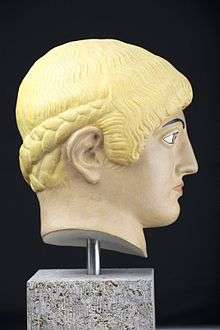

Right image: Ganymede, the hero of Troy, rolling a hoop, Attic vase ca. 500 BC.

.jpg)
On the right: detail of athletic women in the "bikini girls" mosaic of the Villa Romana del Casale, Roman Sicily, 4th century AD
The Greek gods are cited as varying in their appearances. While Poseidon was described as having a blue-black beard and Zeus blue-black eyebrows, Pindar described Athena as fair-haired , and Pheidias described her as golden-haired . Hera, Apollo and Aphrodite were also described as blondes.[62] Pindar collectively described the Homeric Danaans of the time of the war between Argos and Thebes as fair-haired.[62] The Spartans are described as fair-haired by Bacchylides. In the work of Homer, Menelaus the king of the Spartans is, together with other Achaean leaders, portrayed as blond.[62] Although dark hair colours were predominant in the works of Homer, there is only one case of a dark hero, and that is when the blond Odysseus is transformed by Athena and his beard becomes blue-black. Other blond characters in Homer are Peleus, Achilles, Meleager, Agamede, and Rhadamanthys.[62] According to Francis Owens,[63] Roman literary records describe a large number of well-known Roman historical personalities as blond. In addition, 250 individuals are recorded to have had the name Flavius, meaning blond, and there are various people named Rufus and Rutilius, meaning red haired and reddish-haired, respectively. The following Roman gods are said to have had blond hair: Amor, Apollo, Aurora, Bacchus, Ceres, Diana, Jupiter, Mars, Mercury, Minerva and Venus.[63] An emperor, Nero, descended from an aristocratic family, is by the historian Suetonius described as: "... his hair light blond,... his eyes blue..."[64] Augustus, founder of the Roman Empire, is by Suetonius described as having hair that was "... slightly curly and inclining to golden".[65]
The traces of hair color on Greek korai likely reflect the colors the artists saw in natural hair. The hair has a wide range of shades of blond, red, and brown. The minority of statues with blond hair range from strawberry blond up to platinum blond.[66] Sappho of Lesbos (630-570 BC) wrote that purple colored wraps as headdress were good enough, except if the hair was blonde; ...for the girl who has hair that is yellower than a torch (it is better to decorate it) with wreaths of flowers in bloom.[67]
According to Victoria Sherrow, those Romans who were fair-haired preferred to dye their hair dark in the early period of Ancient Rome; at one point in time blond hair was even associated with prostitutes.[68] The preference changed to bleaching the hair blond when Greek culture, which practiced bleaching, reached Rome, and was reinforced when the legions that conquered Gaul returned with blond slaves.[68] Sherrow also states that Roman women tried to lighten their hair, but the substances often caused hair loss, so they resorted to wigs made from the captives’ hair.[69]
Juvenal wrote in a satirical poem that Messalina, Roman empress of noble birth, would hide her black hair with a blonde wig for her nightly visits to the brothel: sed nigrum flavo crinem abscondente galero intravit calidum veteri centone lupanar.[70] In his Commentary on the Aeneid of Virgil, Maurus Servius Honoratus noted that the respectable matron was only black haired, never blonde.[71] In the same passage, he mentioned that Cato the Elder wrote that some matrons would sprinkle golden dust on their hair to make it reddish-color. Emperor Lucius Verus (r. 161 – 169 AD) was said to sprinkle gold-dust on his already "golden" blond hair to make it even blonder and brighter.[72] Commodus (r. 177-192), son of Marcus Aurelius (a co-emperor with Lucius Verus), likewise had naturally curly blond hair.[73]
From an ethnic point of view, Roman authors associated blond and red hair with the Gauls and the Germans: e.g., Virgil describes the hair of the Gauls as "golden" (aurea caesaries),[74] Tacitus wrote that "the Germans have fierce blue eyes, red-blond hair (rutilae comae), huge (tall) frames";[75] in accordance with Ammianus, almost all the Gauls were "of tall stature, fair and ruddy".[76] Celtic and Germanic peoples of the provinces, among the free subjects called peregrini, served in Rome's armies as auxilia, such as the cavalry contingents in the army of Julius Caesar.[77] Some became Roman citizens as far back as the 1st century BC, following a policy of Romanization of Gaul and Lesser Germania.[78] For instance, Gaius Julius Civilis, a prince of the Batavii, was a Roman citizen either by birth or naturalization (as indicated by his name).[79] Before the Constitutio Antoniniana, which granted citizenship to all free men of the empire in 212 AD, entire auxiliary cohorts were occasionally granted citizenship for their performance in battle.[80] Sometimes entire Celtic and Germanic tribes were granted citizenship, such as when emperor Otho granted citizenship to all of the Lingones in 69 AD.[81] By the 1st century BC, the Roman Republic had expanded its control into parts of western Germany, and by 85 AD the provinces of Germania Inferior and Germania Superior were formally established there.[82] Yet as late as the 4th century AD, Ausonius, a poet and tutor from Burdigala, wrote a poem about an Alemanni slave girl named Bissula, who he had recently freed after she'd been taken as a prisoner of war in the campaigns of Valentinian I, noting that her adopted Latin language marked her as a woman of Latium yet her blond-haired, blue-eyed appearance ultimately signified her true origins from the Rhine.[83]
Further south, the Iberian peninsula was originally inhabited by Celtiberians outside of Roman control. The gradual Roman conquest of Iberia was completed by the early 1st century AD.[84] The Romans established provinces such as Hispania Terraconensis that were inhabited largely by Gallaeci, whose red and blond-haired descendants (which also include those of Visigothic origins) have continued to inhabit northern areas of Spain such as Galicia into the modern era.[84] During the medieval period Spanish ladies preferred to dye their hair black, yet by the time of the Renaissance in the 16th century the fashion (imported from Italy) was to dye their hair blond or red.[85]
Classical and Hellenistic Greek depictions
-

The male figure of the Etruscan sarcophagus known as the Sarcophagus of the Spouses (Louvre, Paris), 520-510 BC
-
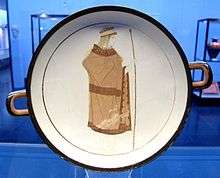
The goddess Hera (according to the description on the cup); tondo of an Attic white-ground kylix from Vulci, ca. 470 BC
-

Hypnos and Thanatos carrying the body of Sarpedon from the battlefield of Troy; detail from an Attic white-ground lekythos, ca. 440 BC.
-
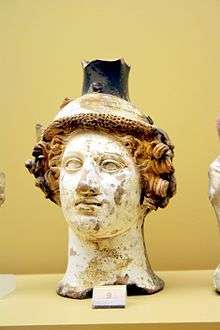
Terracotta vase in the shape of Dionysus' head, ca. 410 BC; on display in the Ancient Agora Museum in Athens, housed in the Stoa of Attalus
-
.jpg)
Attic white-ground lekythos showing a scene of people mourning a recently deceased man, fount at Alopeke (Ambelokepoi) near Athens, c. 400 BC
-
Pottery vessel of Aphrodite in a shell; from Attica, Classical Greece, discovered at Phanagoria, Taman Peninsula (Bosporan Kingdom, southern Russia), early 4th century BC, Hermitage Museum, Saint Petersburg
-
.jpg)
Remnants of a statue of Dionysos, Roman copy of a 4th-century BC Greek original, Palatine Museum, Rome
-
An ancient Greek pottery (terracotta) figurine from Taras (modern Taranto), Magna Graecia, Altes Museum
-
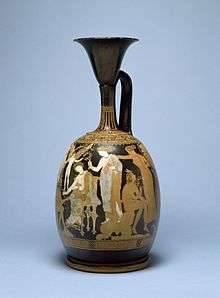
A red-figure pottery (terracotta) "kerch" style lekythos depicting a nymph and satyr playing a game of knucklebones, with two Eros figures (standing between Aphrodite) offering laurel wreaths of victory too the nymph and to a youth, c. 350 BC
-

Hades abducting Persephone, fresco in the small royal tomb at Vergina, Macedonia, Greece, c. 340 BC
-

A mosaic of the Kasta Tomb in Amphipolis depicting the abduction of Persephone by Pluto, 4th century BC
-
%2C_Ancient_Pella_(6913935544).jpg)
Central panel of the Abduction of Helen by Theseus, floor mosaic, detail of the charioteer, from the House of the Abduction of Helen, (c. 300 BC), ancient Pella
-

Stag Hunt Mosaic, possibly depicting Alexander the Great, Pella, Greece, 4th century BC.
-

Alexander the Great (left), wearing a kausia and fighting an Asiatic lion with his friend Craterus (detail); late 4th century BC mosaic from Pella[1]
-
Female acrobat shooting an arrow with a bow in her feet; Gnathia style pelike; 4th century BC
-

Detail of a Gnathia-style krater vase from either Apulia or Campania, 4th century BC, Museo archeologico nazionale (Florence)
-

A Gnathia-style vase from Apulia, 4th century BC, Museo archeologico nazionale (Florence)
-
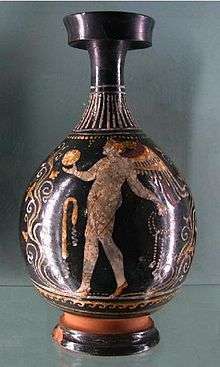
A bottle (Lekythos) in Gnathia style - Eros, with a painting depicting a figure playing with a ball, third quarter of the 4th century BC
-
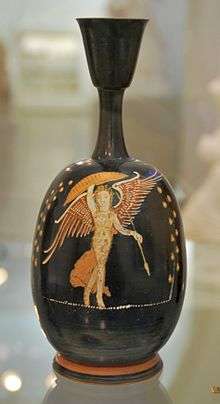
A lekythos bottle in the Gnathia style depicting the winged goddess of victory, Nike, armed and dancing
-

Gnathia ware, southern Italy (Magna Graecia), Apulian vase painting, 310-260 BC, Kinský Palace (Prague)
-
Apulian red-figure Oinochoe with Lid by the Ganymed Painter (Oinochoe) and Armidale Painter (Lid): head in a calyx between tendrils. About 340-310 BC. Antikensammlung Kiel.
-
Detail of a krater with volutes in terracotta; Greek art from Southern Italy, ca. 330-320 BC.
-

Two women bringing offerings to the dead woman sitting in a naiskos. Apulian red-figure loutrophoros, 340–320 BC.
-

Mixing Vessel with a deceased youth, 330-320 BC, Apulian vase painting, Getty Villa
-
A Gnathia-style ceramic vessel from ancient Magna Graecia (Apulia, Italy), depicting a blond winged youth with a Phrygian cap, with lion head spouts, by the "Toledo" painter, c. 300 BC
-

Woman's head on an alabastron in gnathia style; Apulian vase painting, Magna Graecia, Antikensammlung Kiel
-

Sitting woman holding a crown. Terracotta, Apulian vase painting, late 4th century BC. Museum Santa Maria della Scala, Siena.
-
An ancient Apulian Gnathia style "krater" vase from Magna Graecia showing a blond-haired woman playing with a ball.
-
Mosaic of a nymph from the Palace of the Grand Master of the Knights of Rhodes, 2nd century BC
- ^ Olga Palagia (2000). "Hephaestion's Pyre and the Royal Hunt of Alexander," in A.B. Bosworth and E.J. Baynham (eds), Alexander the Great in Fact and Fiction. Oxford & New York: Oxford University Press. ISBN 9780198152873, p. 185.
Ancient Roman depictions
-

Silenus playing the lyre, from the Villa of the Mysteries, Pompeii, c. 50 BC
-

A dancing satyr, fresco from the Villa of the Mysteries, Pompeii, Pompeian Second Style, 1st century BC
-
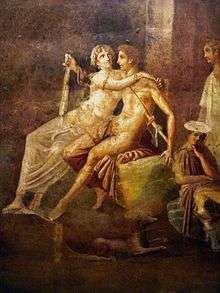
Dido and Aeneus, fresco from the House of Citharist in Pompeii, Italy; Pompeian Third Style (10 BC - 45 AD)
-
Fresco of young man, Villa di Arianna, Stabiae, 1st century AD.
-

Roman fresco from Pompeii showing a Maenad in silk dress, 1st century AD
-
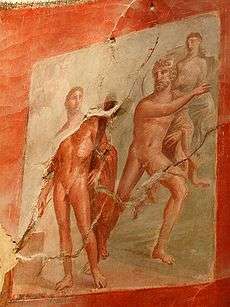
A fresco from Herculaneum depicting Heracles and Achelous from Greco-Roman mythology, 1st century AD
-
Polyphemus hears of the arrival of Galatea; ancient Roman fresco painted in the "Fourth Style" of Pompeii (45-79 AD)
-
A fresco depicting Theseus, from Herculaneum (Ercolano), Italy, 45-79 AD
-
_her_hair%2C_from_the_Villa_of_Arianna_at_Stabiae_(Castellammare_di_Stabia)%2C_Naples_National_Archaeological_Museum_(17392924485).jpg)
Fresco showing a woman looking in a mirror as she dresses (or undresses) her hair, from the Villa of Arianna at Stabiae, 1st century AD
-
Polyphemus receiving a letter from Galatea, Pompeii, Fourth Style (45-79 AD)
-
.jpg)
Fresco depicting a seated woman, from the Villa Arianna at Stabiae, 1st century AD
-
Heracles and Omphale, Pompeian Fourth Style (45-79 AD)
-
Heracles as a child, Pompeii, Pompeian Fourth Style (45-79 AD)
-
Roman fresco of a blond maiden reading a text, Pompeian Fourth Style (60-79 AD), Pompeii
-

Dye worker's shop of Veranius Hypsaeus, fresco from Pompeii, 1st century AD
-

The so-called "Venus in a bikini", from the House of Julia Felix, Pompeii, Italy actually depicts the Roman goddess Aphrodite as she is about to untie her sandal, with a small Eros squating beneath her left arm
-
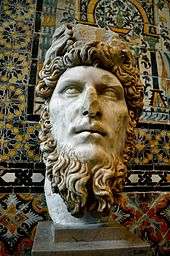
Ancient bust of Roman emperor Lucius Verus (r. 161-169) in the Bardo National Museum, Tunis
-
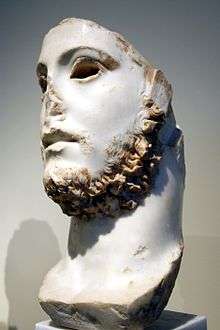
Remnants of a Roman bust of a youth with a blond beard, perhaps depicting Roman emperor Commodus (r. 177-192), National Archaeological Museum, Athens
-

Polychrome marble statue depicting the goddess Tyche holding the infant Plutus in her arms, 2nd century AD, Istanbul Archaeological Museum
-
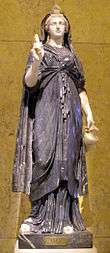
Ancient Roman statue of Isis, in the Collection of Greek and Roman Antiquities in the Kunsthistorisches Museum, Vienna; first half of the 2nd century AD, found in Naples, Italy; made out of black and white marble.
-
_(3470740119).jpg)
Marble table support adorned by a group including Dionysos, Pan and a Satyr; Dionysos holds a rhyton in the shape of a panther; traces of red and yellow colour are preserved on the hair of the figures and the branches; from an Asia Minor workshop, AD 170-180, National Archaeological Museum, Athens, Greece
-

Bust of Tiberius Julius Sauromates II (d. 210 AD), ruler of the Bosporan Kingdom in Roman Crimea, one of Rome's client states
-
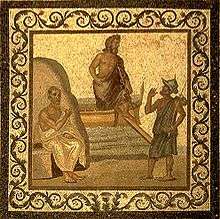
Asclepius (center) arrives in Kos and is greeted by Hippocrates (left) and a citizen (right), mosaic, 2nd-3rd century AD
-
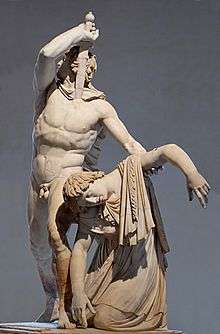
Ludovisi Gaul 2nd-century AD Roman copy of a 3rd-century BC Hellenistic original from Pergamon, Palazzo Altemps
-

Wall fragment with fresco of a Gallo Roman man, from Evreux, 250-275 AD
-
A blond man in a Roman fresco from Klagenfurt, Austria, Landesmuseum für Kärnten
-
.jpg)
Fresco with Dionysian scenes from a Roman villa of Cologne, Germany (site of the ancient city Colonia Claudia Ara Agrippinensium), 3rd century AD, Romano-Germanic Museum
-
.jpg)
Fresco with Dionysian scenes from a Roman villa of Cologne, Germany (site of the ancient city Colonia Claudia Ara Agrippinensium), 3rd century AD, Romano-Germanic Museum
-
.jpg)
Fresco with Dionysian scenes from a Roman villa of Cologne, Germany (site of the ancient city Colonia Claudia Ara Agrippinensium), 3rd century AD, Romano-Germanic Museum
-

Roman mosaic depicting a feminine personification, from the Boathouse of Psyche in Daphne (suburb of Antioch), beginning of 3rd century AD, Louvre Museum
-
A boy holding a platter of fruits and what may be a bucket of crabs, in a kitchen with fish and squid, on the June panel from a mosaic depicting the months (3rd century)[1]
-
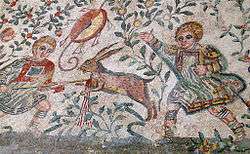
A mosaic of young boys hunting from the Villa Romana del Casale, Roman Sicily, 4th century AD
-

A mosaic depicting a game hunt, from the Villa Romana del Casale, Roman Sicily, 4th century AD
-
A mosaic depicting a game hunt, from the Villa Romana del Casale, Roman Sicily, 4th century AD
-

Triumph of Poseidon and Amphitrite showing the couple in procession, detail of a mosaic from Cirta, Roman Africa, 315–325 AD, Louvre
-
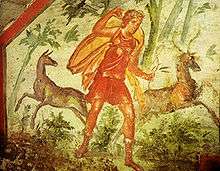
A Roman fresco depicting the goddess Diana hunting, 4th century AD, from the Via Livenza hypogeum in Rome
- ^ J. Carson Webster, The Labors of the Months in Antique and Mediaeval Art to the End of the Twelfth Century, Studies in the Humanities 4 (Northwestern University Press, 1938), p. 128. In the collections of the Hermitage Museum.
Color reconstructions based on trace pigment analysis
-

Color reconstruction of statue of a young girl from the Parthenon in Athens, 520 BC. Based on analysis of trace pigments.
-
East Frieze detail (6th-5th century BC) representing the battle of Troy, Achilles against Memnon; color reproduction of the Treasury of Siphnos - Delphi, Archaeological Museum of Delphi
-
.jpg)
Reconstructed polychromy of a vase-shaped tombstone from Athens, c. 330 BC, Ny Carlsberg Glyptotek, Copenhagen
-

The Greek goddess Artemis. Color reconstruction of a 1st-century AD statue found in Pompeii. Reconstructed using analysis of trace pigments. It was an imitation of Greek statues of the 6th century BC.
-

The Treu Head, Second century AD. Color reconstruction of marble head of likely a goddess. The head was found at the Esquiline Hill, Rome, and preserves numerous colour traces.
Northern Europe

In Norse mythology, the goddess Sif has famously blonde hair, which some scholars have identified as representing golden wheat.[86] In the Poetic Edda poem Rígsþula, the blond man Jarl is considered to be the ancestor of the dominant warrior class.
In Northern European folklore, supernatural beings value blonde hair in humans. Blonde babies are more likely to be stolen and replaced with changelings, and young blonde women are more likely to be lured away to the land of the beings.[87] Elves and fairies were often portrayed with blond hair in illustrations in children's book of fairy tales. This continues the theme that blond hair is associated with beauty and goodness.
Contemporary popular culture
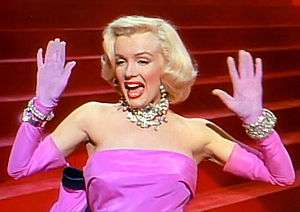
In contemporary popular culture, it is often stereotyped that men find blond women more attractive than women with other hair colors.[68] For example, Anita Loos popularized this idea in her 1925 novel Gentlemen Prefer Blondes.[68] Blondes are often assumed to have more fun; for example, in a Clairol commercial for hair colorant, they use the phrase "Is it true blondes have more fun?"[68] Some women have reported they feel other people expect them to be more fun-loving after having lightened their hair.[68] In much of the Americas, such as in North America, the "blonde stereotype" is also associated with being less serious or less intelligent.[68] This can be seen in blonde jokes.[68] In Brazil, this extends to blonde women being looked down, as reflected in sexist jokes, as also sexually licentious.[88] It is believed the originator of the "dumb blonde" was an 18th-century blonde French prostitute named Rosalie Duthé whose reputation of being beautiful but dumb inspired a play about her called Les Curiosites de la Foire (Paris 1775).[68] Blonde actresses have contributed to this perception; some of them include Marilyn Monroe, Judy Holliday, Jayne Mansfield, and Goldie Hawn during her time at Laugh-In.[68]
Alfred Hitchcock preferred to cast blonde women for major roles in his films as he believed that the audience would suspect them the least, comparing them to "virgin snow that shows up the bloody footprints", hence the term "Hitchcock blonde".[89] This stereotype has become so ingrained it has spawned counter-narratives, such as in the 2001 film Legally Blonde in which Reese Witherspoon succeeds at Harvard despite biases against her beauty and blonde hair,[68] and terms developed such as cookie cutter blond (CCB), implying standardized blond looks and standard perceived social and intelligence characteristics of a blond. Many actors and actresses in Latin America and Hispanic United States have blond hair, blue eyes, and pale skin.[90][91][92][93][94][95][96][97][98]
In colloquial Quebec French, "ma blonde" means "my girlfriend", regardless of the color of the specific woman's hair. Such is for example the reference in the name of the still-current 17th century chanson "Auprès de ma blonde".
See also
- Science
- Society
References
- ↑ "blonde|blond, adj. and n.". OED Online. March 2012. Oxford University Press. Web. 17 May 2012.
- ↑ Harper, Douglas. "Blond (Adj.)." Online Etymology Dictionary. Web. 17 May 2012.
- ↑ Origin of "blonde", from Online Etymology Dictionary.
- ↑ "5. Gender: Sexist Language and Assumptions § 2. blond / brunet". The American Heritage Book of English Usage. A Practical and Authoritative Guide to Contemporary English. Bartleby.com. 1996. Archived from the original on September 7, 2008. Retrieved October 24, 2013.
- 1 2 3 "blonde, blond, a. and n." The Oxford English Dictionary. 2nd ed. 1989. OED Online. Oxford University Press. 5 Aug. 2010.
- ↑ Penny cyclopaedia of the Society for the Diffusion of Useful Knowledge, s.v. Albinos. Society for the Diffusion of Useful Knowledge (Great Britain, 1833).
- ↑ "blonde, blond, a. and n." The Oxford English Dictionary. June 2006 [draft editions]. OED Online. Oxford University Press. 5 Aug. 2010
- ↑ "brunet, a. and n." The Oxford English Dictionary. June 2006 [draft editions]. OED Online. Oxford University Press. 5 Aug. 2010
- ↑ "brunette, n. and a." The Oxford English Dictionary. June 2006 [draft editions]. OED Online. Oxford University Press. 5 Aug. 2010.
- ↑ "blonde, blond, a. and n." The Oxford English Dictionary. Additions Series 1997. OED Online. Oxford University Press. 5 Aug. 2010.
- ↑ "Ash-blond". Merriam-Webster.
- ↑ "Peroxide blond". Dictionary.com.
- ↑ "Flaxen". The American Heritage Dictionary of the English Language (Fourth ed.). Yahoo! Education. 2000. Archived from the original on May 12, 2007. Retrieved October 24, 2013.
- ↑ "Flaxen". Merriam-Webster.
- ↑ "Dirty blond". Dictionary.com.
- ↑ "Dishwater blonde". Encarta. Archived from the original on 2009-10-31.
- ↑ "Platinum blonde". Merriam-Webster.
- ↑ "Towhead". The American Heritage Dictionary of the English Language (Fourth ed.). Yahoo! Education. 2000. Archived from the original on June 26, 2008. Retrieved October 24, 2013.
- ↑ "Towhead". Merriam-Webster.
- ↑ "Sandy". The American Heritage Dictionary of the English Language (Fourth ed.). Yahoo! Education. 2000. Archived from the original on April 10, 2005. Retrieved October 24, 2013.
- ↑ "Sandy". Merriam-Webster.
- ↑ "Strawberry blond". The American Heritage Dictionary of the English Language (Fourth ed.). Yahoo! Education. 2000. Archived from the original on February 12, 2009. Retrieved October 24, 2013.
- ↑
- Nenarokoff-Van Burek, Anne (2013). Ariadne's Thread: The Women in My Family. FriesenPress. ISBN 9781460207192. Retrieved October 24, 2013.
- Davydov, Denis Vasilʹevič (1999). Troubetzkoy, Gregory, ed. In the Service of the Tsar Against Napoleon: The Memoirs of Denis Davidov, 1806-1814. Greenhill Books/Lionel Leventhal, Limited. ISBN 9781853673733. Retrieved October 24, 2013.
- Sutherland, Daniel E. (March 1, 2000). The Expansion of Everyday Life, 1860-1876. University of Arkansas Press. ISBN 9781610751452. Retrieved October 24, 2013.
- Browne, Ray Broadus; Kreiser, Lawrence A. (January 1, 2003). The Civil War and Reconstruction. Greenwood Publishing Group. ISBN 9780313313257. Retrieved October 24, 2013.
- France, Anatole (2010). Works of Anatole France. MobileReference. ISBN 9781607785422. Retrieved October 24, 2013.
- ↑ "Cavegirls were first blondes to have fun", from The Times. Note, the end of the Times article reiterates the disappearing blonde gene hoax; the online version replaced it with a rebuttal.
- ↑ Dobson, Roger; Taher, Abul (2006-02-26). "A corrected version of "Cavegirls were first blondes to have fun"". The Times. London. Retrieved 2010-04-26.
- ↑ Robins, Ashley H. Biological perspectives on human pigmentation. Cambridge University Press, 1991, pp. 195–208.
- 1 2 Abstract: "European hair and eye colour: A case of frequency-dependent sexual selection?" from Evolution and Human Behavior, Volume 27, Issue 2, Pages 85-103 (March 2006)
- ↑ "Frost: Why Do Europeans Have So Many Hair and Eye Colors?". cogweb.ucla.edu. Retrieved 2016-08-21.
- 1 2 P, Skoglund; H, Malmström. "Genomic diversity and admixture differs for Stone-Age Scandinavian foragers and farmers.". Science (journal). doi:10.1126/science.1253448.
- 1 2 Haak, W.; Lazaridis, I. "Massive migration from the steppe was a source for Indo-European languages in Europe". Nature (journal). doi:10.1038/nature14317.
- 1 2 Wilde, Sandra; Timpson, Adrian. "Direct evidence for positive selection of skin, hair, and eye pigmentation in Europeans during the last 5,000 years". PNAS (journal). doi:10.1073/pnas.1316513111.
- 1 2 3 4 Kenny, Eimear E.; Timpson, Nicholas J. (4 May 2012). "Melanesian Blond Hair Is Caused by an Amino Acid Change in TYRP1". Science (journal).
- 1 2 Corbyn, Zoë (3 May 2012). "Blonde hair evolved more than once". Nature.com.
- 1 2 Ridley, Matt. Red Queen: Sex and the Evolution of Human Nature. Published by HarperCollins, 2nd ed. 2003, pp. 293–294.
- ↑ http://webspace.ship.edu/cgboer/race.html"
- ↑ https://unsafeharbour.wordpress.com/2012/02/19/distribution-of-light-hair-and-eyes-in-europe/
- ↑ Cavalli-Sforza, L., Menozzi, P. and Piazza, A. (1994). The History and Geography of Human Genes. Princeton: Princeton University Press.
- ↑ Coon, Carleton S. The Races of Europe. Retrieved 9 July 2013.
France as a whole, finds but 4 per cent of black and near-black hair color, 23 per cent of dark brown, 43 per cent of medium brown,. 14 per cent of light brown, 12 per cent of various degrees of blond, and some 4 per cent of reddish-brown and red. (...)
The regional distribution of hair color in France follows closely that of stature. Although the position of the French in regard to hair pigmentation is intermediate between blond and black, the diagonal line from Mont St. Michel to Orleans, Lyons, and the Italian border divides the country into a northeastern quadrant, in which the hair is somewhat lighter than medium, and a southwestern, in which it is somewhat darker. High ratios of black and very dark brown hair are found not in the typically Alpine country, but along the slope of the Pyrenees, in Catalan-speaking country, and on the Mediterranean seacoast. Blond hair is commonest along the Channel, in regions settled by Saxons and Normans, in Burgundy and the country bordering Switzerland, and down the course of the Rhône. In northern France it seems to follow upstream the rivers which empty into the Channel. The hair color of the departments occupied by Flemish speakers, and of others directly across the Channel from England in Normandy, seems to be nearly as light as that in the southern English counties; the coastal cantons of Brittany are lighter than the inland ones, and approximate a Cornish condition. In the same way, the northeastern French departments are probably as light-haired as some of the provinces of southern Germany. - ↑ La Depeche, 5 millions de blondes en France, dont 50% de fausses
- ↑ Tamagnini Eusebio: "A Pigmentacao dos Portugueses". Coimbra: Universidade de Coimbra. Instituto de Antropologia Portuguesa, 1936. Contribuicoes para o Estudo da Antropologia Portuguesa. Vol. VI, no. 2, 1936 pp. 121–197.
- ↑ Mendes Correa: American Journal of Physical Anthropology, Vol 2, 1919.
- ↑ Coon, Carleton S. The Races of Europe. Retrieved 9 July 2013.
In Spain, as a whole, some 29 per cent of the male population has black hair, some 68 per cent dark brown, while traces of blondism are visible in 17 per cent. (...) As in southern Spain, the skin color is evenly divided between a light brown, 45 per cent, and brunet-white, 45 per cent, while pinkish-white skins are found in only one-tenth of the population.122 Again as in Spain, the prevailing hair color is dark brown, which amounts to 68 per cent of the total; blond and red hair is limited to 2 per cent
- ↑ http://www.theapricity.com/snpa/bilder/biasuttiblondism.jpg
- ↑ "(Chapter XI, section 13) Eastern Barbary, Algeria and Tunisia". SNPA. Retrieved 13 March 2013.
- ↑ C. Wilfred Griggs, "Excavating a Christian Cemetery Near Selia, in the Fayum Region of Egypt", in Excavations at Seila, Egypt, ed. C. Wilfred Griggs, (Provo, Utah: Religious Studies Center, Brigham Young University, 1988), 74–84.
- ↑ Egyptian Cemetery May Contain a Million Mummies History, December 19, 2014
- ↑ "Modern Human Variation: Overview". Anthro.palomar.edu. 2009-11-08. Retrieved 2009-12-20.
- 1 2 "Gene Expression: Blonde Australian Aboriginals". Gnxp.com. Retrieved 2009-12-20.
- ↑ Gray, John. (1977). The World of Hair, A Scientific Companion, Macmillan Press Limited
- 1 2 3 Wilde 2014.
- 1 2 3 4 5 Allentoft 2015.
- 1 2 3 Haak 2015.
- ↑ Keyser, Christine; Sikora, Caroline. "Ancient DNA provides new insights into the history of south Siberian Kurgan people". Springer (journal). doi:10.1038/nature14507.
- ↑ Shoumatoff, Nicholas; Shoumatoff, Nina (2000). Around the Roof of the World. University of Michigan Press. p. 9. ISBN 0-472-08669-3.
- ↑ Vishnevsky, Anatoly. (15 August 2000). "Replacement Migration: Is it a solution for Russia?" (PDF). EXPERT GROUP MEETING ON POLICY RESPONSES TO POPULATION AGEING AND POPULATION DECLINE /UN/POP/PRA/2000/14. United Nations Population Division, Department of Economic and Social Affairs. pp. 6,10.
- ↑ Gene pool and genegeography of population: Vol. 1. Nauka. 2000. ISBN 5020258237.
- ↑ Balaresque, Patricia; Bowden, Georgina R.; Adams, Susan M.; Leung, Ho-Yee; King, Turi E.; et al. (2010). Penny, David, ed. "A Predominantly Neolithic Origin for European Paternal Lineages". PLOS Biology. Public Library of Science. 8 (1): e1000285. doi:10.1371/journal.pbio.1000285. PMC 2799514
 . PMID 20087410. Retrieved August 19, 2014.
. PMID 20087410. Retrieved August 19, 2014. - ↑ "The results of the national population census in 2009". Agency of Statistics of the Republic of Kazakhstan. 12 November 2010. Retrieved 21 January 2010.
- ↑ Flynn, Moya (1994). Migrant resettlement in the Russian federation: reconstructing homes and homelands. ISBN 1843311178.
- ↑ Ramet, S. Petra (1993). Religious Policy in the Soviet Union. Cambridge University Press. ISBN 9780521416436.
- ↑ Robert Greenall, Russians left behind in Central Asia, BBC News, 23 November 2005
- 1 2 3 4 Myres, John Linton (1967). Who were the Greeks?, pp. 192-199. University of California Press.
- 1 2 " (Francis Owen,The Germanic people; their Origin Expansion & Culture", 1993 Barnes & Noble Books ISBN 0-88029-579-1, page 49.)
- ↑ "Suetonius • Life of Nero". Penelope.uchicago.edu. Retrieved 2008-12-22.
- ↑ "Suetonius • The Life of Augustus". Penelope.uchicago.edu. Retrieved 2015-04-10.
- ↑ Mary Stieber, The Poetics of Appearance in the Attic Korai, p. 66-68. University of Texas Press
- ↑ Mary Stieber, The Poetics of Appearance in the Attic Korai, p.156. University of Texas Press
- 1 2 3 4 5 6 7 8 9 10 11 Victoria Sherrow. Encyclopedia of hair: a cultural history. Page 149
- ↑ Victoria Sherrow, For Appearance' Sake: The Historical Encyclopedia of Good Looks, Beauty, and Grooming, Greenwood Publishing Group, p. 136, Google Books
- ↑ Juv. 2.6.120-121
- ↑ Serv. A. 4.698
- ↑ Michael Grant (1994). The Antonines: The Roman Empire in Transition. London & New York: Routledge. ISBN 0-415-10754-7, pp 27-28.
- ↑ Colin Wells (2004) [1984, 1992]. The Roman Empire. Second Edition (sixth reprint edition). Cambridge, MA: Harvard University Press. ISBN 0-674-77770-0, p 255.
- ↑ Virg. Aen. 8.659
- ↑ Tac. Germania 4
- ↑ Amm. 15.12.1
- ↑ Goldsworthy, Adrian (2000). Roman Warfare. Edited by John Keegan. Cassell, p. 126.
- ↑ Rüger, C. (2004) [1996]. "Germany". In Alan K. Bowman; Edward Champlin; Andrew Lintott. The Cambridge Ancient History: X, The Augustan Empire, 43 B.C. - A.D. 69. 10 (2nd ed.). Cambridge University Press. pp. 523–526. ISBN 0-521-26430-8.
- ↑ Tacitus, Annales IV.12
- ↑ Goldsworthy, Adrian (2005) The Complete Roman Army. Thames & Hudson, p. 97.
- ↑ Tacitus, Annales I.78
- ↑ Rüger, C. (2004) [1996]. "Germany". In Alan K. Bowman; Edward Champlin; Andrew Lintott. The Cambridge Ancient History: X, The Augustan Empire, 43 B.C. - A.D. 69. 10 (2nd ed.). Cambridge University Press. pp. 527–528. ISBN 0-521-26430-8.
- ↑ Wolfram, Herwig (1997) [1990]. The Roman Empire and Its Germanic Peoples. Translated by Thomas Dunlap. Berkeley, Los Angeles, London: University of California Press. ISBN 0-520-08511-6. p. 65.
- 1 2 James B. Minahan (2000). One Europe, Many Nations: a Historical Dictionary of European National Groups. Westport and London: Greenwood Press. ISBN 0-313-30984-1, p. 278.
- ↑ Eric V. Alvarez (2002). "Cosmetics in Medieval and Renaissance Spain", in Janet Pérez and Maureen Ihrie (eds), The Feminist Encyclopedia of Spanish Literature, A-M. 153-155. Westport and London: Greenwood Press. ISBN 0-313-29346-5, p. 154
- ↑ Ellis Davidson, H. R. (1965). Gods and Myths of Northern Europe, page 84. Penguin. ISBN 0-14-013627-4
- ↑ Katharine Briggs, An Encyclopedia of Fairies, Hobgoblins, Brownies, Boogies, and Other Supernatural Creatures, "Golden Hair", p194. ISBN 0-394-73467-X
- ↑ Revista Anagrama, Universidade de São Paulo, Stereotypes of women in blonde jokes pp. 6-8, version 1, edition 2, 2007
- ↑ Allen, Richard (2007). Hitchcock's Romantic Irony. Columbia University Press. ISBN 978-0-231-13574-0.
- ↑ Quinonez, Ernesto (2003-06-19). "Y Tu Black Mama Tambien". Retrieved 2008-05-02.
- ↑ The Blond, Blue-Eyed Face of Spanish TV
- ↑ Blonde, Blue-Eyed Euro-Cute Latinos on Spanish TV
- ↑ Latinos Not Reflected on Spanish TV
- ↑ What are Telenovelas? – Hispanic Culture
- ↑ Racial Bias Charged On Spanish-Language TV
- ↑ Black Electorate
- ↑ Jones, Vanessa E. (2004-08-19). "Pride or Prejudice?". Boston.com. Retrieved 2010-09-08.
- ↑ POV - Corpus Film Description
External links
| Look up blond in Wiktionary, the free dictionary. |
| Wikimedia Commons has media related to Blond hair. |
| Wikimedia Commons has media related to Blond hair in art. |









